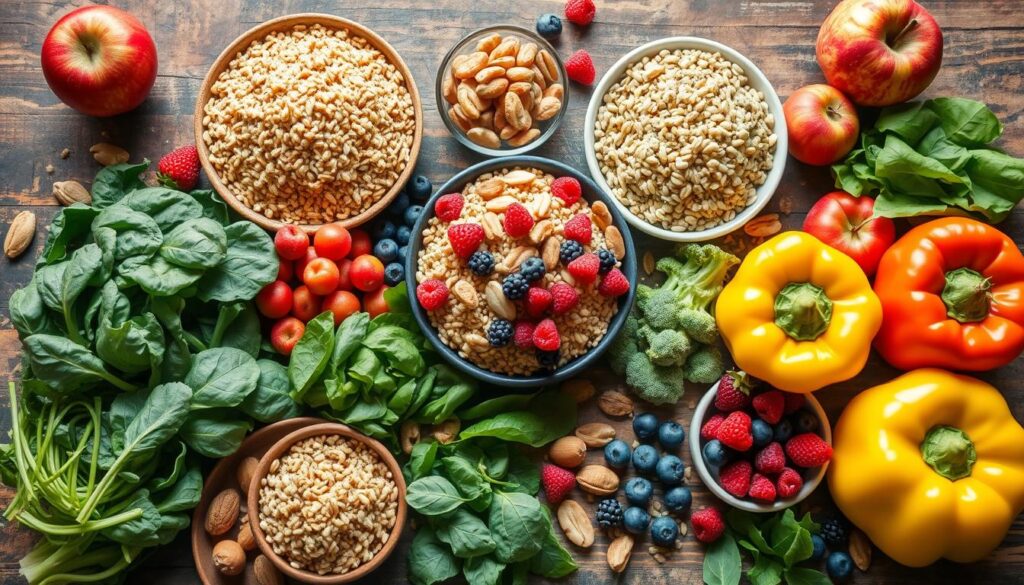Did you know that choosing low-glycemic foods can greatly improve your health? These foods help keep your blood sugar stable, reduce cravings, and aid in weight management. In this article, we’ll dive into the world of low-glycemic foods and how they can change your life.

Key Takeaways
- Low-glycemic foods help regulate blood sugar levels and prevent spikes and crashes.
- Incorporating low-glycemic foods into your diet can support weight loss and management.
- These nutrient-dense options provide long-lasting energy and promote feelings of fullness.
- Whole grains, legumes, fruits, and vegetables are excellent sources of low-glycemic carbohydrates.
- Adopting a low-glycemic lifestyle is a sustainable way to improve your overall health and well-being.
Understanding the Glycemic Index
Healthy eating can seem hard, but knowing the glycemic index helps a lot. It rates foods by how they affect your blood sugar. This knowledge lets you choose better for your health.
What is the Glycemic Index?
The glycemic index is a scale from 0 to 100, with 100 being glucose. Foods get a score based on how they raise your blood sugar. Foods with a score below 55 raise it slowly, while those above 70 raise it quickly.
How the Glycemic Index is Measured
To find a food’s glycemic index, researchers follow a set process. They have people eat 50 grams of carbs from the food and then check their blood sugar. They compare this to eating pure glucose, which is 100. This helps figure out the food’s glycemic index, showing how it affects your blood sugar and carbohydrate use.
Knowing the glycemic index and eating low-glycemic index foods can help manage your blood sugar. This supports your health and wellness. Keep reading for more on the good of low-glycemic foods and how to add them to your diet.
The Benefits of Low-Glycemic Foods
The carbs you eat can greatly affect your health. Low-glycemic foods help control blood sugar levels. They offer many benefits for your overall health. Adding these foods to your diet can help you achieve better health.
Stable Blood Sugar Levels
Low-glycemic foods are great for keeping blood sugar stable. They don’t cause sudden spikes or drops like high-glycemic foods do. This steady energy is good for people with diabetes or those trying to manage their weight.
Improved Satiety and Weight Management
These foods also make you feel fuller for longer. They are more filling and take longer to digest. This can help you manage your weight better and avoid too much snacking.
Low-glycemic foods are good for blood sugar control, weight management, and a balanced diet. Exploring their benefits is worth it.
Low-Glycemic Foods: What They Are and Why They Matter
Looking for a healthier diet? Learning about low-glycemic foods is key. They help keep your blood sugar levels stable, which is good for your health.
So, what are low-glycemic foods? They’re whole, natural foods packed with fiber, complex carbs, and nutrients. They digest slowly, causing blood sugar to rise gradually. This is different from high-glycemic foods that cause quick spikes.
Low-glycemic foods are full of nutrients. They give you energy that lasts, helping you stay focused and active. They also help with weight management by making you feel full longer, so you eat less.
Adding low-glycemic foods to your diet can greatly improve your health. They help control blood sugar and support a healthy weight. These foods are a great choice for anyone looking to eat better.

By choosing low-glycemic foods, you’re taking a big step towards a healthier life. These foods are packed with nutrients. They can help you feel your best and live a balanced lifestyle.
Incorporating Low-Glycemic Foods into Your Diet
Switching to a low-glycemic diet is easy. Just a few simple steps can help you add these foods to your meals and snacks. Find easy recipes and meal plans to make your transition smooth.
Begin by planning your meals ahead. Each week, look for low-glycemic recipes and make a meal plan. This keeps you on track and ensures you have the right foods. Focus on whole grains, lean proteins, legumes, and lots of fruits and veggies.
For quick meals, try these swaps:
- Swap white rice for quinoa or brown rice
- Use whole wheat bread or wraps instead of white bread
- Replace sugary snacks with fresh fruit, nuts, or Greek yogurt
- Experiment with different low-glycemic vegetables like leafy greens, broccoli, and bell peppers
Finding foods and recipes you like is key. Try new ingredients and cooking methods. Get creative in the kitchen. By adding low-glycemic foods to your diet, you’ll enjoy a healthier lifestyle.

Whole Grains and Legumes: Powerhouses of Low-Glycemic Goodness
Whole grains and legumes are key to a low-glycemic diet. They help keep blood sugar stable and are rich in fiber and vitamins. Let’s look at the variety of whole grains and the many ways to use legumes for tasty, healthy meals.
Exploring Whole Grain Options
Whole grains are great for those looking for low-glycemic foods. They keep the germ and bran, which are full of nutrients. This makes them a good source of fiber and other important nutrients. Some top whole grains include:
- Brown rice
- Quinoa
- Oats
- Whole wheat bread and pasta
- Barley
- Bulgur
The Versatility of Legumes
Legumes, like beans, lentils, and peas, are also good choices. They are high in fiber and offer a steady flow of nutrients and complex carbohydrates. This helps control blood sugar. You can use legumes in many dishes, from soups to salads.
Adding whole grains and legumes to your diet opens up a world of low-glycemic benefits. These foods help keep blood sugar stable, make you feel full, and support your health.
Low-Glycemic Fruits and Vegetables
Low-glycemic fruits and vegetables are key to a healthy diet. They offer lots of nutrients and fiber. Fiber helps control blood sugar and boosts overall health.
Embrace the Goodness of Low-Glycemic Fruits
Fruits like berries, citrus, and stone fruits are great for their low glycemic index. They’re full of antioxidants, vitamins, and minerals. Enjoy grapefruit, peaches, and raspberries for their taste and to keep blood sugar stable.
Embrace the Goodness of Low-Glycemic Vegetables
Low-glycemic vegetables are plentiful. Choose from leafy greens and cruciferous veggies. Add broccoli, kale, and Brussels sprouts to your meals. They’re rich in fiber, vitamins, and minerals, supporting your health.
By focusing on low-glycemic fruits and vegetables, you’ll please your taste buds and nourish your body. Enjoy their vibrant colors, natural flavors, and fiber for a healthier lifestyle.
Tips for Maintaining a Low-Glycemic Lifestyle
Starting a low-glycemic lifestyle is a journey worth taking. Begin by planning your meals ahead of time. This makes it simpler to pick low-glycemic foods. When you grocery shop, choose whole foods like fruits, veggies, whole grains, and lean proteins. Always check nutrition labels to find low-glycemic options.
Eating out can be tricky, but you can still stick to your low-glycemic lifestyle. Look for dishes with whole, unprocessed ingredients. If needed, ask for special changes to fit your diet. With some planning and attention, you can enjoy meals out while staying healthy.
Success in a low-glycemic lifestyle comes from finding what works for you. Try out new recipes and ingredients. Remember, it’s okay to have treats sometimes. The benefits of a low-glycemic diet are worth the effort for your health and happiness.
FAQ
What are low-glycemic foods?
Low-glycemic foods don’t raise your blood sugar much. They digest slowly, keeping your blood sugar steady. This prevents big spikes and drops.
Why are low-glycemic foods important?
Eating low-glycemic foods has many benefits. They help keep your blood sugar stable, which is key for diabetes management. They also make you feel full, aiding in weight control.
How is the glycemic index measured?
The glycemic index rates foods from 0 to 100. Foods with a score of 55 or less are low-glycemic. Those scoring 70 or higher are high-glycemic.
What are some examples of low-glycemic foods?
Low-glycemic foods include whole grains like quinoa and brown rice. Legumes, most fruits and veggies, and healthy fats like avocados are also good choices.
How can I incorporate more low-glycemic foods into my diet?
To eat more low-glycemic foods, plan your meals and make simple changes. Choose whole grains over refined carbs. Eat lean proteins and healthy fats. Fill your plate with low-glycemic fruits and veggies. Try new recipes and find low-glycemic versions of your favorites.

